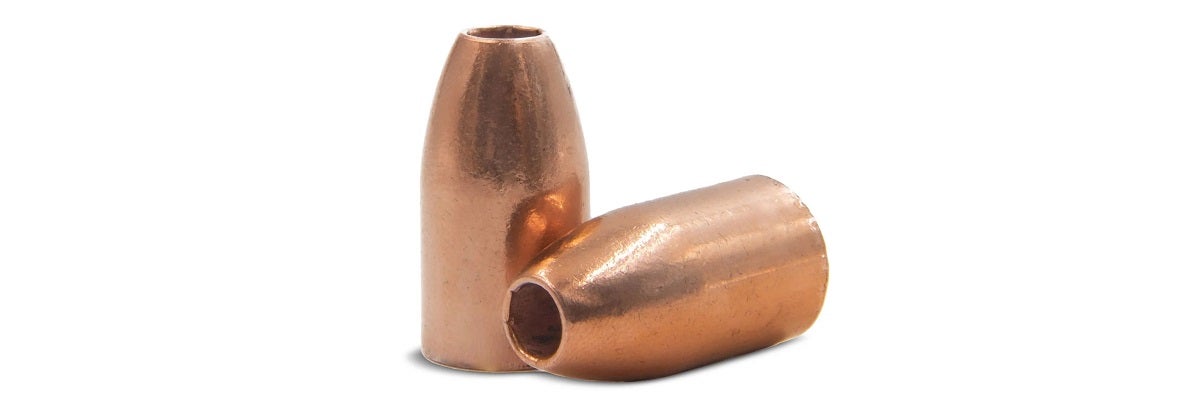Travis Olander 01.02.24
Confused by the rifle above? Yes, it is, in fact, black powder. It’s an AR-15 converted into a bolt-action, inline, .45-caliber muzzleloader, produced by Uinta Precision. Gone are the days of smoothbore muskets that are only good to a hundred yards, or so. Today, rifled blackpowder guns can strike target steel and take American game as handily as centerfire rifles. Today, we will dive into the ammunition and potential accuracy of blackpowder guns in Part 2 of our Blackpowder Guide.
Blackpowder Content on AllOutdoor
Blackpowder Guide – Types of Blackpowder Ammo
With the right ammo, you can certainly achieve AR-like accuracy at impressive distances without the need for smokeless powder and cartridges. Or, you can commit to erstwhile authenticity and load up some good ole’ lead balls and patches. Here’s everything you need to know about blackpowder ammo.
Blackpowder Guide – Lead Round Ball

The primordial firearm projectile, round balls are still relied upon by muzzleloading enthusiasts today – though this is to satisfy the curiosity of the thing, not for any performance. Round ball ammo’s available for handguns and long guns alike, with common diameters ranging from 0.32″ to 0.58″ caliber.
Round ball can be shot from rifled barrels, but a slow twist rate is necessary – usually 1:60 or slower. Lead ball ammo is seldom perfectly round, and the shape provides a small area of contact between the ball and barrel. This results in a poorer seal than with conical bullets. Though not strictly necessary, lead balls should be loaded with patches.
Blackpowder Guide – What are Patches?

Not to be confused with cleaning patches, shooting patches have long been used to increase chamber pressure and muzzle velocity. This is done by wrapping the projectile in the patch before rodding it into the barrel. This forms a tighter seal between the projectile and barrel. Patches are used almost exclusively with round ball ammo. In addition to providing a better seal, patches can also be oiled or lubricated. This helps to protect the barrel against fouling and oxidation caused by the ignited powder.
Blackpowder Guide – Conical Rounds

Traditional conical rounds, like these Thompson Center Maxi-Balls, are made from lead, like ball rounds. But they’re shaped similarly to modern cartridge bullets, featuring a conical tip, straight walls along the sides, and a flat or boattail end. The yellow segments in between the layers of lead are polymer rings; these reduce friction and fouling and make loading easier. Conical rounds provide a better seal inside the chamber and barrel and offer a better ballistic coefficient than round ball projectiles. The result is greater muzzle velocity and accuracy, without the need for shooting patches – though patches can still be used to further improve velocity and accuracy.
Like modern cartridge bullets, muzzleloading conical rounds can be formed as full metal jackets, or as hollow points, expanding upon impact to provide greater lethality and terminal performance. Conical rounds perform better across a wider range of twist rates than ball rounds, too – they’re capable of handling twist rates ranging from 1:32 to 1:48 with good accuracy and no risk of under- or over-stabilization.
Blackpowder Guide – Sabot Rounds

Sabot rounds, exampled by these .50-cal Harvester Scorpions, provide arguably the best performance. The sabot – a polymer casing surrounding the bullet itself, which separates as the round exits the muzzle – acts as a modern patch, of sorts. It provides a sight seal against the barrel, improving chamber pressure and muzzle velocity. Sabot rounds require faster twist rates than naked projectiles – regardless of the caliber or barrel length, a 1:28 to 1:30 rate of twist is ideal. Picking the optimal sabot round is a game of mixing and matching. Each rifle’s bore is unique, and so is the sabot round from various manufacturers.
Generally, Harvester, Hornady, and Barnes provide the most consistent loads by caliber, balancing a tight fit with relatively easy loading and consistent accuracy. It’s important to note, however, that sabot rounds are banned for hunting in many states. Always check the regulations governing your state’s muzzleloader season before investing in these rounds for taking game.
Blackpowder Guide – Belted Rounds

Belted rounds, like these PowerBelt Platinum Aerotips, provide the benefits of a sabot round without the need to test out different variants. In essence, the round is precisely manufactured to measure just under the bore diameter – usually a thousandth of an inch – while utilizing a snap-on base that functions as a gas seal. The seal eliminates gaseous blow-by and improves chamber pressure and velocity, without the extra fight necessary to ram the projectile with a rod, like you’ll often experience with sabot rounds. Like sabots, belted rounds prefer a fast twist rate, especially considering the underbore diameter – usually 1:28 or faster is ideal. The benefit of belted rounds is also the consistency of the fit, which results in more consistent chamber pressures and more predictable accuracy, while spreading less debris sound downrange than a sabot.
Blackpowder Guide – Full-Bore Rounds

Full-bore copper rounds, like these Thor Hammers in .50-cal, are as close as one can get to firing centerfire projectiles from a muzzleloader or blackpowder gun. They’re made entirely of copper and are fashioned as full metal jackets or hollow points, providing superb accuracy and knockdown power for hunting. Although superior to regular conical rounds, copper full-bores need to be precisely fitted to your rifle’s barrel. It’s recommended you test various diameters by the thousands of an inch to achieve an appropriate fit. Once the fit is achieved, you’ll enjoy practically unmatched performance. In Part 3 of our guide to Blackpowder, we’re going over the last component of making an accurate, reliable, and safe blackpowder setup: powder and primers.
